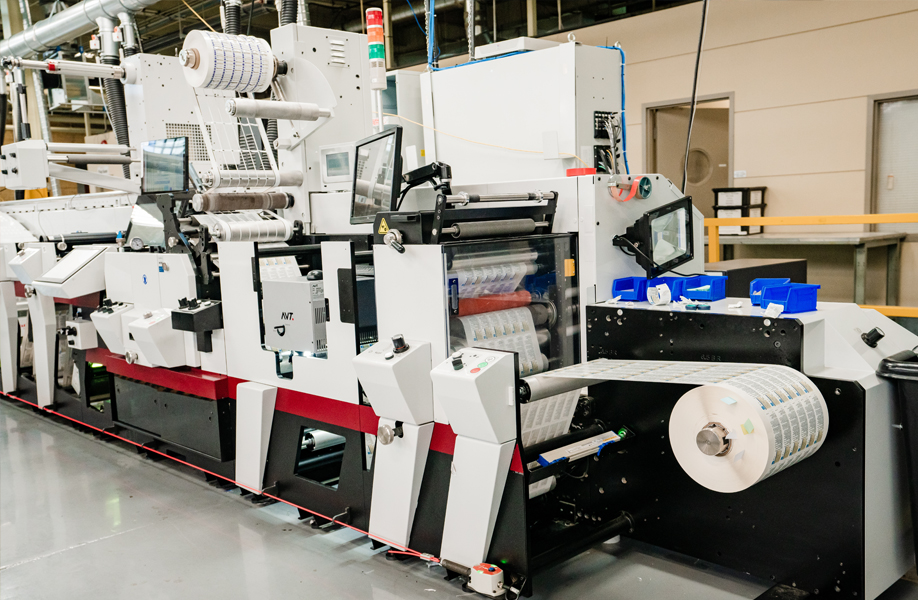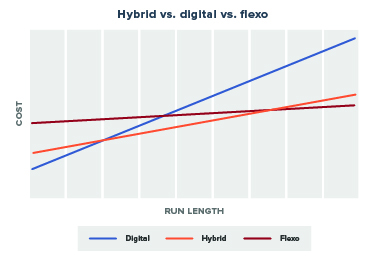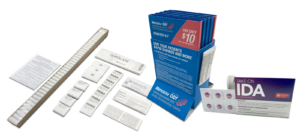Hybrid label printing: Cost, appearance and performance considerations

When ordering labels, three questions always get asked:
- Will they exactly match my brand vision?
- Will it perform in my product’s end-use environment?
- How much are my labels going to cost?
And while many factors affect the price, appearance and performance of your labels, press technology is chief among them.
The press dictates production speed, make-ready waste and tooling costs — all of which impact your overall label spend. And, of course, the way your label is printed will impact the way it displays on the shelf and performs in its end-use environment.
The traditional label press technology debate has had two players: Flexographic vs. digital. Now, a third player has entered the stage: Hybrid printing technology.
Here, we’ll expand on the “digital-versus-flexo” debate to include hybrid printing, exploring when hybrid does and doesn’t provide the best value for your labels.
First of all, what is hybrid label printing technology?
Hybrid presses are like the Prius of label printing, combining the best features of digital and flexographic printing technology.
So, in order to understand hybrid, you need a basic understanding of digital and flexo.
Flexographic printing presses have multiple stations which can be used to mount plates for CMYK printing, spot color printing, applying cold foil, screen printing, laminating or applying varnishes. The in-line finishing capabilities are a key benefit — allowing you to produce finished labels in a single pass on the press. But because flexo presses rely on analog processes, there’s a fixed tooling cost associated with every graphics variation (plates) and custom embellishment (dies for screen printing, tactile varnishes, etc.). Still, flexo presses offer unparalleled throughput speeds — and for long runs, the speed gains greatly outweigh the initial investment in tooling.
Plate-free digital printing eliminates plate costs and allows you to vary your graphics label by label with variable data printing. This makes digital printing a great fit for product lines with many SKUs, or for promotional campaigns requiring personalization. As long as the labels share the same dimensions (as with flavor variations of the same product), you can group many different orders into one long run and achieve cost efficiencies.
Hybrid printing presses have flexographic printing stations — which can be used for CMYK printing, spot colors, varnishes and more — as well as a digital printing module which can be used for variable data printing. Our proprietary hybrid printing offering, Digital Impact, boasts a high level of ink coverage and density that offers a die-free alternative to screen printing for producing opaque whites. And eliminating dies eliminates tooling costs.
Value crossover: Hybrid vs. digital vs. flexo
The value crossover point between the three press technologies looks like this:

Very generally speaking:
- Digital makes the most sense for small runs. This is because digital printing does not require an upfront investment in plates. But because it doesn’t run as quickly as a flexo press, it becomes less cost-effective as the order size goes up.
- Flexo offers unparalleled value for long runs with little variation. The tooling investment associated with flexo printing is easily neutralized by speed gains for large label orders.
- Hybrid offers the best value for medium runs. With the in-line finishing capabilities of flexo, hybrid is competitive for medium to large orders. With the variable data printing capabilities of digital printing, hybrid minimizes changeover time and allows for the grouping of different SKUs and flavor variations within one order. Perfect for small to medium orders with a high level of variation.
But the chart is an oversimplification. It neglects to consider the many, many factors beyond run length and cost that impact label value, appearance and performance.
To see what the chart doesn’t tell you about the value difference between digital, flexo and hybrid technologies, keep reading.
Determining if hybrid printing is the right fit for your labels
None of the three press technologies we’ve discussed are better than the other. Of course, there are certain scenarios in which each will deliver superior value — but none of them, not even hybrid, is a catch-all.
It’s best to work with a label converter that provides all three.
If all you have is a digital press, every label order looks like a perfect-fit for digital. But converters that have flexographic, digital and hybrid presses will guide you toward the best technology for every order.
And selecting the right press technology isn’t a matter of either/or. Many brands would benefit from using a mix of all three across their product portfolio.
For your flagship product — where you’ll print millions of labels with the same exact graphics — flexo is likely the best fit. Perhaps you’re running a promotional campaign for one of your product lines that requires label-by label variation. Then digital is probably the best fit.
Below, we’ll narrow in on a few examples where hybrid is the best fit.
Hybrid vs. digital
There are three primary advantages of hybrid over digital:
- Production speed — When using pure digital presses, the printed labels must be removed and placed on a finishing press for any embellishments. On hybrid presses, many embellishments (screen printing, cold foil, varnish) can be done in a single pass on the press. This saves production time, and those savings are passed on to the brand owner.
- Abrasion resistance — Our inkjet hybrid presses use UV-cured inks rather than the heat-cured inks of pure digital presses. UV-cured inks offer enhanced abrasion resistance.
- Opacity — The digital module on our hybrid presses rivals the opacity of screen printing, even for whites. The ink is applied heavily, even to the point it appears raised and glossy. This allows you to get the effect of a screen-printed, super-opaque white without the cost of screen-printing dies.
Even with the myriad benefits of hybrid, digital still provides the best value in many situations. For very short runs with a lot of variability (SKUs, flavors, personalization), digital is often the best bet as long as high ink opacity isn’t required.
Hybrid vs. flexo
Because of its throughput speeds, pure flexo printing will always be the most cost-effective option for long runs with no variation.
But hybrid presses allow you to group multiple SKUs together into one order, printing common art elements with flexo, printing variable art elements (e.g., product or flavor name) with the digital module and finishing the labels in-line. With fewer plates and fewer changeovers, you’ll save significantly.
As it pertains to label appearance, hybrid printing offers tighter traps, better registration and infinite color combinations for cold foils, replacing the need for costly hot stamp dies.
The more complex your label graphics, and the greater variation required, the better suited it will be for hybrid printing.
Hybrid printing might be the right choice if …
- You need a medium to large order of labels for a product with many flavors or varieties. Hybrid printing would reduce (if not eliminate) your plate costs and significantly reduce production time. All of this translates to more cost-effective labels for your brand.
- Your label embellishments are limited to varnishes, cold foil, screen printing and laminates. If so, printing and finishing your labels in one pass may present significant cost savings.
- Ink opacity is a key concern. Hybrid presses give you screen-print level opacity without investing in screen-printing dies.
- Your product will be exposed to moisture or abrasion. Compared with pure digital presses, the UV-cured inks used in hybrid presses offer superior performance for products that will be stored in wet or abrasive environments.
Hybrid printing isn’t a silver bullet. It’s another tool in the brand owner’s toolbox.
There isn’t a simple conclusion to the “digital-vs-flexo-vs-hybrid” debate. And when you do see black-and-white statements — “Digital is the best option! Here’s why!” — it, unsurprisingly, usually comes from a label supplier that only has digital presses.
Presses are simply tools. There’s a place for each of the three technologies we discussed — just as sometimes you need a wrench, and other times you need a saw.
So what label technology is best for your brand?
The one that saves your brand money while delivering on your packaging vision.
With a large coast-to-coast footprint of digital, hybrid and flexo presses, we have the redundant capacity to produce your labels in the most cost-effective way for your product. And the experience of our press operators is what ensures we will deliver on your brand vision on every label — regardless of which technology you use.
Tags:



